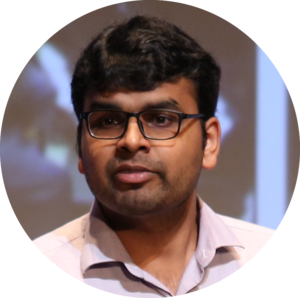Computational Studio: A computational machinery to enhance social communication (Talk)
Licklider and Taylor (1968) envisioned computational machinery that could enable better communication between humans than face-to-face interaction. In the last fifty years, we have used computing to develop various means of communication, such as mail, messaging, phone calls, video conversation, and virtual reality. These are, however, a proxy of face-to-face communication that aims at encoding words, expressions, emotions, and body language at the source and decoding them reliably at the destination. The true revolution of personal computing has not begun yet because we have not been able to tap the real potential of computing for social communication. A computational machinery that can understand and create a four-dimensional audio-visual world can enable humans to describe their imagination and share it with others. In this talk, I will introduce the Computational Studio: an environment that allows non-specialists to construct and creatively edit the 4D audio-visual world from sparse audio and video samples. The Computational Studio aims to enable everyone to relive old memories through a form of virtual time travel, to automatically create new experiences, and share them with others using everyday computational devices. There are three essential components of the Computational Studio: (1) how can we capture 4D audio-visual world?; (2) how can we synthesize the audio-visual world using examples?; and (3) how can we interactively create and edit the audio-visual world? The first part of this talk introduces the work on capturing and browsing in-the-wild 4D audio-visual world in a self-supervised manner and efforts on building a multi-agent capture system. The applications of this work apply to social communication and to digitizing intangible cultural heritage, capturing tribal dances and wildlife in the natural environment, and understanding the social behavior of human beings. In the second part, I will talk about the example-based audio-visual synthesis in an unsupervised manner. Example-based audio-visual synthesis allows us to express ourselves easily. Finally, I will talk about the interactive visual synthesis that allows us to manually create and edit visual experiences. Here I will also stress the importance of thinking about a human user and computational devices when designing content creation applications. The Computational Studio is a first step towards unlocking the full degree of creative imagination, which is currently limited to the human mind by the limits of the individual's expressivity and skill. It has the potential to change the way we audio-visually communicate with others.
Biography: Aayush Bansal is a Ph.D. candidate at the Robotics Institute of Carnegie Mellon University, where he is advised by Prof Deva Ramanan and Prof Yaser Sheikh. He is a Presidential Fellow at CMU, and a recipient of Uber Presidential Fellowship (2016-17), Qualcomm Fellowship (2017-18), and Snap Fellowship (2019-20). Various national and international media such as NBC, CBS, France TV, and The Journalist have extensively covered his work.


